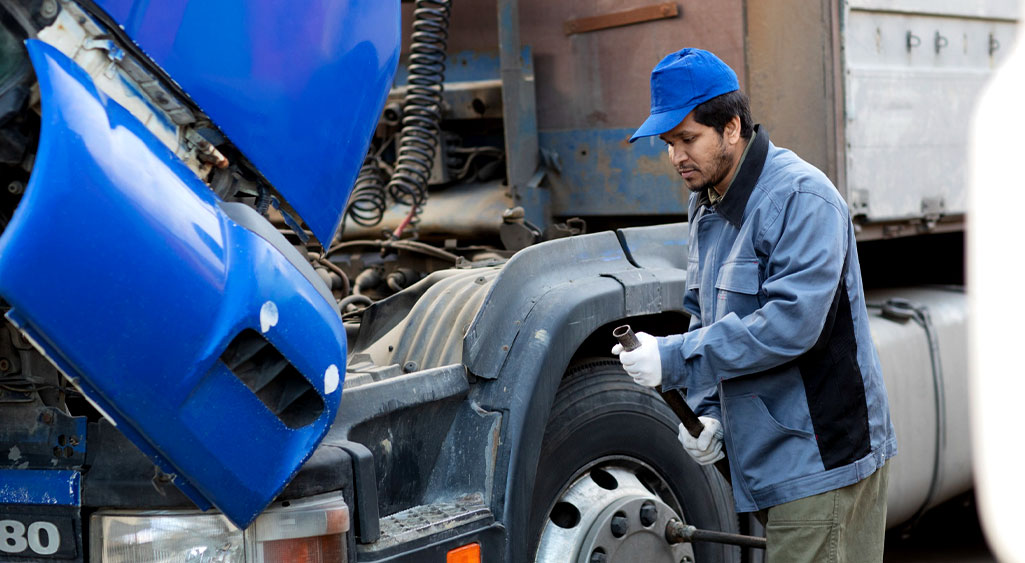
 Request FREE consultation - 1866-758-4529
Request FREE consultation - 1866-758-4529 
Semi-trucks are a common sight on our highways, carrying goods across vast distances. Their size and weight make them a force to be reckoned with on the road. Brakes are an integral part of semi trucks, ensuring their safe operation.
A key component that ensures the safety of these giants is their braking system. The brakes on a semi truck not only protect the driver and cargo, but also other road users.
In this article, we delve into the importance of semi-truck brakes, their key components, and the best practices for maintaining them. Understanding these aspects can significantly enhance road safety and vehicle performance.
The primary role of semi-truck brakes is to ensure safety. Given the massive size and weight of these vehicles, robust braking systems are crucial.
Brakes allow the driver to control the vehicle’s speed and stop it when necessary. This control is vital to prevent accidents and maintain road safety standards.
Moreover, properly functioning brakes are a legal requirement. Meeting these safety standards helps avoid fines and penalties.
Brake failure is a leading cause of truck-related accidents. Regular maintenance and understanding of the braking system can help prevent such incidents.
Lastly, the braking system also plays a role in the performance of the vehicle. It affects fuel efficiency, tire wear, and overall vehicle lifespan.
Big truck brakes are complex systems. They consist of several key components that work together to slow down and stop the vehicle.
One of these components is the brake pad. Brake pads are critical and need regular checks for wear and tear.
Another key component is the brake drum or disc. These parts work with the brake pads to create the friction needed to stop the vehicle.
Air brakes are also a common feature in big rigs. They use air pressure to activate the brake pads and drums.
Lastly, modern semi trucks often include anti-lock braking systems (ABS). ABS prevents wheel lockup during sudden stops, enhancing safety.
Brake pads are subject to significant wear and tear. Regular checks and replacements are necessary to maintain brake performance.
Brake pads should be inspected for thickness and even wear. Uneven wear can indicate issues with other brake components.
Finally, using high-quality brake pads can enhance safety and reliability. It’s an investment that pays off in the long run.
 Air brakes are a common feature in big trucks. They use air pressure to activate the braking system.
Air brakes are a common feature in big trucks. They use air pressure to activate the braking system.
The air pressure pushes against the brake pads and drums. This creates the friction needed to slow down and stop the vehicle.
Maintaining proper air pressure levels is crucial. Low air pressure can lead to reduced braking power and potential brake failure.
Understanding how air brakes work can help in identifying potential issues. It’s a key part of truck brake maintenance.
Preventing brake failure is a top priority. Regular maintenance is key to ensuring the brakes function properly.
One common issue is brake fade. This happens when brakes overheat and lose effectiveness.
To prevent this, drivers can use engine brakes or retarders. These devices help reduce wear on the brake pads.
Anti-lock braking systems (ABS) are also helpful. They prevent wheel lockup during sudden stops.
Regular inspections are crucial. They should be part of a pre-trip checklist.
Brake adjustment is also important. It ensures the brakes respond properly when applied.
Neglecting these steps can lead to increased repair costs and downtime.
The weight and distribution of cargo can affect brake performance. Heavier loads require more braking power.
Improperly distributed cargo can also cause issues. It can lead to uneven brake wear and reduced braking efficiency.
Understanding these factors is crucial for safe and effective trucking operations.
More than a million lives are lost every year in ghastly road accidents worldwide. And recent studies indicate that the figures can go even higher over the next ten years!
Truck accidents in the US are often caused by mechanical faults, including engine defects, sudden brake failures, improper adjustments, or poor maintenance. Brakes are an important part of any vehicle; they help slow down the vehicle to stop it.
Nowadays, brakes have been improved to give more safety and durability. Some of the latest developments include an inboard braking system, brake assist, an anti-lock brake system, and dynamic and cornering brake control.
Some truckers and commercial drivers have the latest technology to ensure maximum protection for themselves as well as other road travelers. During emergency situations where the driver has to apply sudden braking, such modern engineering feats have helped trucks stop quickly, thus avoiding some serious truck crashes.
Maintaining the semi trucks in good condition and checking the braking system every day, as required by the trucking regulations, can really save lives. Those truck drivers who frequently use traffic-congested highways in Texas should make it a point to keep their brake systems in perfect working form and check them each and every day.
However, it is also crucial to be prepared for the worst. In such circumstances, victims of truck accidents in Texas can easily contact some of the best truck accident law firms in the country to investigate a big rig wreck. In appropriate cases, a qualified semi-truck accident attorney will demand to inspection of the tractor-trailer’s brakes if the brakes’ condition may be an issue in what caused the truck wreck. Many good Texas truck wreck lawyers are dedicated to helping victims seek justice and maximize personal injury insurance claims.
Often, it is only after a top truck accident lawyer has been hired and a truck crash investigation has started that the condition of the brakes becomes known.
If you have been injured in an accident with an 18-wheeler or other commercial vehicle, call our expert truck accident lawyers for a free consultation.
Related Articles:
Braking distance of semi trucks
Little Known Facts About 18-Wheelers